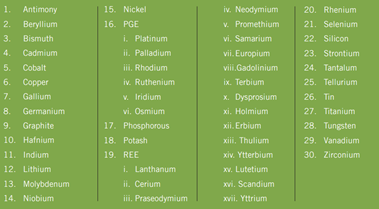Table of Contents
Critical Minerals
Context: The Centre has cancelled the auction of 3 critical mineral blocks.
About Critical Minerals
- Critical minerals are mineral resources, both primary and processed, that are essential inputs in modern technologies, economies, and national security.
- The risk of supply chain disruption characterises them due to non-availability and price volatility.
- These minerals play a crucial role in various industries and sectors and have limited substitutes, making them strategically important.
- Elements included: It includes metallic and non-metallic elements such as Antimony, Beryllium, Cobalt, Germanium, Graphite, Indium, Lithium, Niobium, 17 Rare earths (heavy and light), Rhenium, Tantalum, Silicon, Strontium, Vanadium, Zirconium etc.
- Significance: They are critical as their associated impact on the economy is relatively higher than the other raw materials and they have limited substitutes.

Appointment of Governors
Context: President Droupadi Murmu appointed governors in 9 states.
About Appointment of Governor
- The Governor is neither directly elected by the people nor indirectly elected by a specially constituted electoral college as is the case with the President.
- He/she is appointed by the President of India by warrant under his hand and seal (Article 155).
- While drafting the Constitution, the ‘Canadian model of Governor’ appointment by the Centre was accepted in the Constituent Assembly.
- Qualifications:
- The Constitution lays down only two qualifications for the appointment of a person as a governor.
- He/she should be a citizen of India.
- He/she should have completed the age of 35 years.
- The Constitution lays down only two qualifications for the appointment of a person as a governor.
- Additionally, two conventions have also developed in this regard over the years.
- He/she should be an outsider, meaning not belonging to the State of appointment so as to remain free from the local politics.
- While appointing the Governor, the President is required to consult the Chief Minister of the State concerned, so that the smooth functioning of the constitutional machinery is ensured.
- Constitutional Provisions:
- Article 153: Article 153 of the Indian Constitution mandates the appointment of a Governor in each state. The 7th Amendment to the Constitution, however, allows for the appointment of the same person as Governor of two or more states.
- Article 154: The Governor shall have executive power over the state, which he shall exercise either directly or through officers subordinate to him in conformity with this Constitution.
- Article 163: There shall be a council of ministers, led by the Chief Minister, to assist and advise the Governor in the exercise of his powers, except when he is compelled to execute his functions at his discretion.
- Article 164: The council of ministers is collectively responsible to the state’s legislative assembly. This provision is the cornerstone of the state’s parliamentary system of governance.
CITES
Context: India has successfully prevented the inclusion of agarwood (Aquilaria malaccensis) in the Review of Significant Trade (RST) under the Convention on International Trade in Endangered Species of Wild Fauna and Flora (CITES).
About CITES
- Aim: To ensure that international trade in wild animals and plants does not threaten their survival.
- Establishment: Adopted in 1973 and entered into force in 1975.
- Member: 184 member parties and trade is regulated in more than 38,000 species.
- Secretariat: Administered by the United Nations Environment Programme (UNEP) and is located in Geneva, Switzerland.
- Representatives Meet: Every two to three years at a Conference of the Parties (COP) to review progress and adjust the lists of protected species.
- Although CITES is legally binding on the Parties, it does not replace national laws; instead, Parties are required to implement the Convention.
- Categories with different levels of protection:
- Appendix I: Includes species threatened with extinction and provides the highest level of protection, including a prohibition on commercial trade.
- Appendix II: Includes species that are not currently threatened with extinction but may become so without trade controls. Regulated trade is allowed with an export permit ensuring legal acquisition and non-detrimental trade to the species’ survival or its ecosystem role.
- Appendix III: Includes species for which a country has requested assistance from other CITES parties to control international trade. Trade is regulated using CITES export permits and certificates of origin.
- Countries can list species with domestic regulations in Appendix III at any time.
- CITES also facilitates collaboration among law enforcement officers from wildlife authorities, national parks, customs, and police agencies to combat wildlife crime targeting animals.


 National Technology Readiness Assessment...
National Technology Readiness Assessment...
 Justice Mission-2025: China’s Live-Fir...
Justice Mission-2025: China’s Live-Fir...
 Suryastra: First Made-in-India Long-Rang...
Suryastra: First Made-in-India Long-Rang...

























